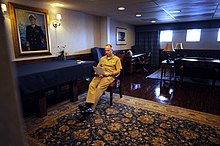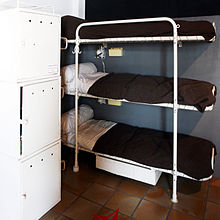Cabin (ship)
This articleneeds additional citations forverification.(December 2008) |

Acabinorberthingis an enclosed space generally on ashipor anaircraft.A cabin which protrudes above the level of a ship'sdeckmay be referred to as adeckhouse.
Sailing ships[edit]


Insailing ships,the officers and paying passengers would have an individual or shared cabin. Thecaptainorcommanding officerwould occupy the "great cabin" that normally spanned the width of thesternand had large windows.
On a warship, it was a privileged area, separate from the rest of the ship, for the exclusive use of the captain. In large warships, the cabin was subdivided into day and night cabins (bedrooms) by movable panels, calledbulk-heads,that could be removed in time of battle to leave the cabin clear for the gunners to use thestern chasersseveral of which were usually stationed in the cabin.
On largethree deckerwarships in theage of sailthe captain's cabin was sometimes appropriated by theAdmiral.The captain would be consigned to the cabin below on the middlegun-deck.
Modern warships[edit]

In most modernwarships,the commanding officer has a main cabin—thein-port cabin,often adjacent to the ship's central control room (operations room)—and asea cabinadjacent to thebridge.Thus, when likely to be called from sleep or attending to administration, the commanding officer can go to the sea cabin and thereby be able to appear at the bridge or operations room immediately. The sea cabin is sparsely equipped, containing just a bunk, a desk, and basic toilet facilities. The in-port cabin is more lavishly furnished, with separate bedroom and combinationsitting room/office, and more elaborate toiletry facilities.[1][2]
For ships intended to act asflagships,like the formerUnited States Navyaircraft carrierUSSLexington—now amuseum ship—the admiral also has a sea cabin (adjacent to the captain's sea cabin) and an in-port cabin, in addition to the captain's cabins.
Officers normally have their own cabins—sometimes referred to asstaterooms—which double as their offices. Some seniorpetty officersmay have cabins for similar reasons.
Sailors sleep inberthing spaces.
Passenger ships[edit]
In ships carryingpassengers,they are normally accommodated in cabins, taking the terminology familiar to seafarers. First-class cabins were traditionally referred to asstaterooms,and today many cruise lines now prefer to refer to passenger cabins as staterooms or suites.
Cabin crawl[edit]
Incruise shipterms, a cabin crawl is an event where passengers tour the cabins of fellow passengers. A cruise ship may also offer a cabin crawl of cabins or suites which did not sell for a particular sailing. The purpose of a cabin crawl is to give passengers an idea of the space and layout of various cabin options for their next cruise. Cabin crawls are normally organized prior to a cruise, through cruise-fan websites.[3][4]
Spacecraft[edit]
Inspacecraft,cabins are required to fully supply food andoxygenfor their crew. On missions lasting a year or longer, the cabins have to be self-sustaining, i.e. replenish their own water and oxygen. The space cabin for any long-range crewed mission is expected to be reasonably spacious, with approximately 28 cubic metres allotted to each occupant. In addition, cabins have life support systems that should have the capability to meet a variety of off-nominal conditions, including cabin fires, depressurization, and component shutdown or failure. Frequently, these conditions occur so quickly that recovery can be provided only by automatic control systems. In the late 1960s, several experimental ground facilities were developed to evaluate regenerative life support systems for crewed space flight.[5]
See also[edit]
References[edit]
- ^James L. Holloway III (2007).Aircraft Carriers at War.Naval Institute Press. p. 201.ISBN978-1-59114-391-8.
- ^C. Snelling Robinson (2000).200,000 Miles Aboard the Destroyer Cotten.The Kent State University Press. p. 11.ISBN978-0-87338-698-2.
- ^"Cruise Critic Board".Cruise Critic.Retrieved7 July2015.
- ^"Cabin Crawl".Cabin Crawl.Retrieved7 July2015.
- ^Averill, R.D. (August 1968)."A systems analysis of a regenerative cabin atmosphere control system".Langley Research Center.NASA (published 1968).RetrievedNovember 2,2013.
